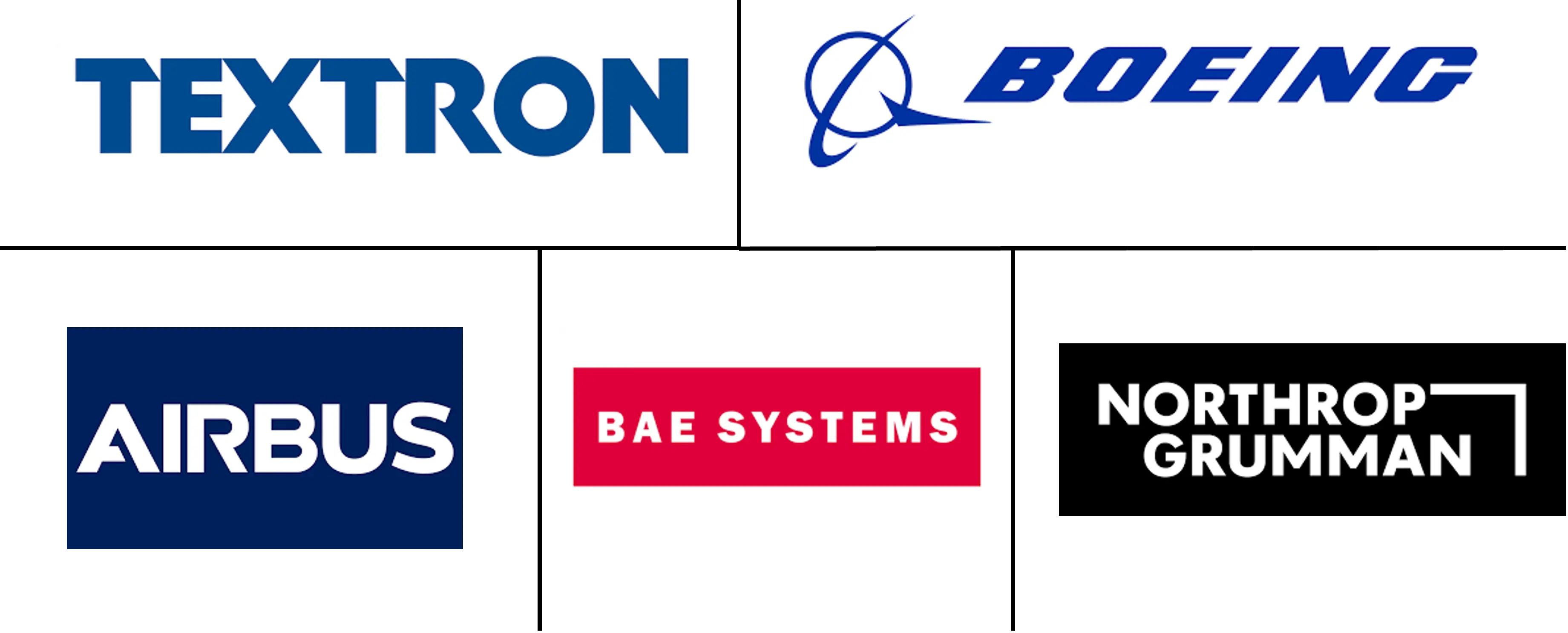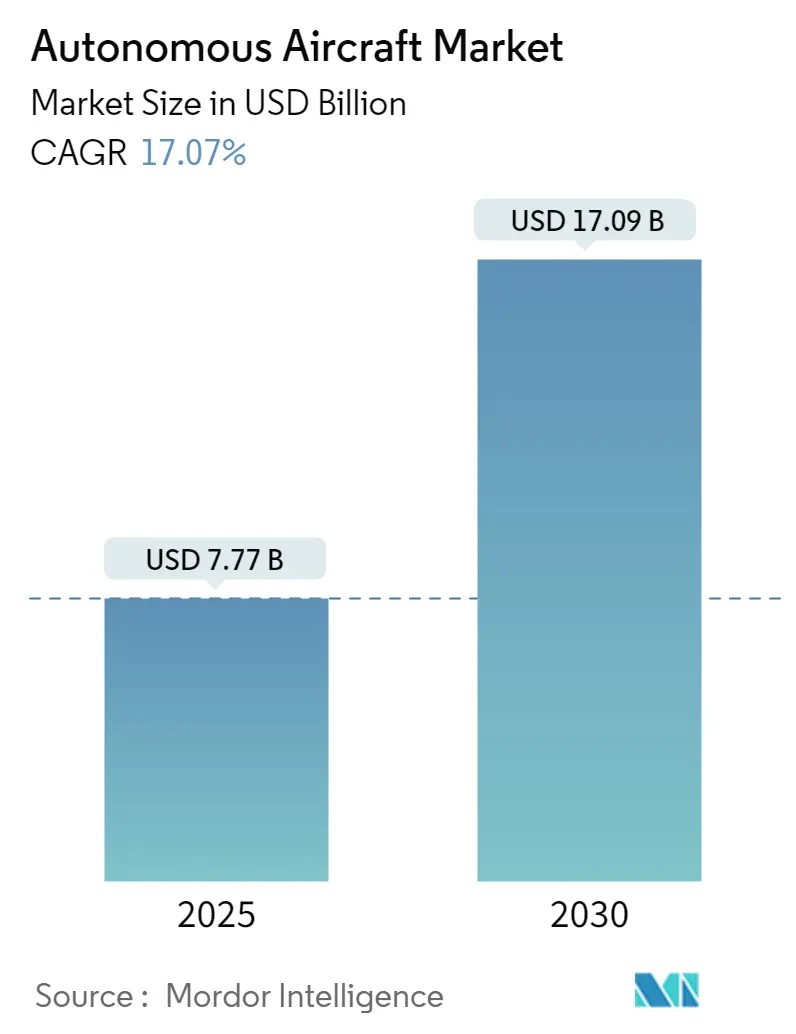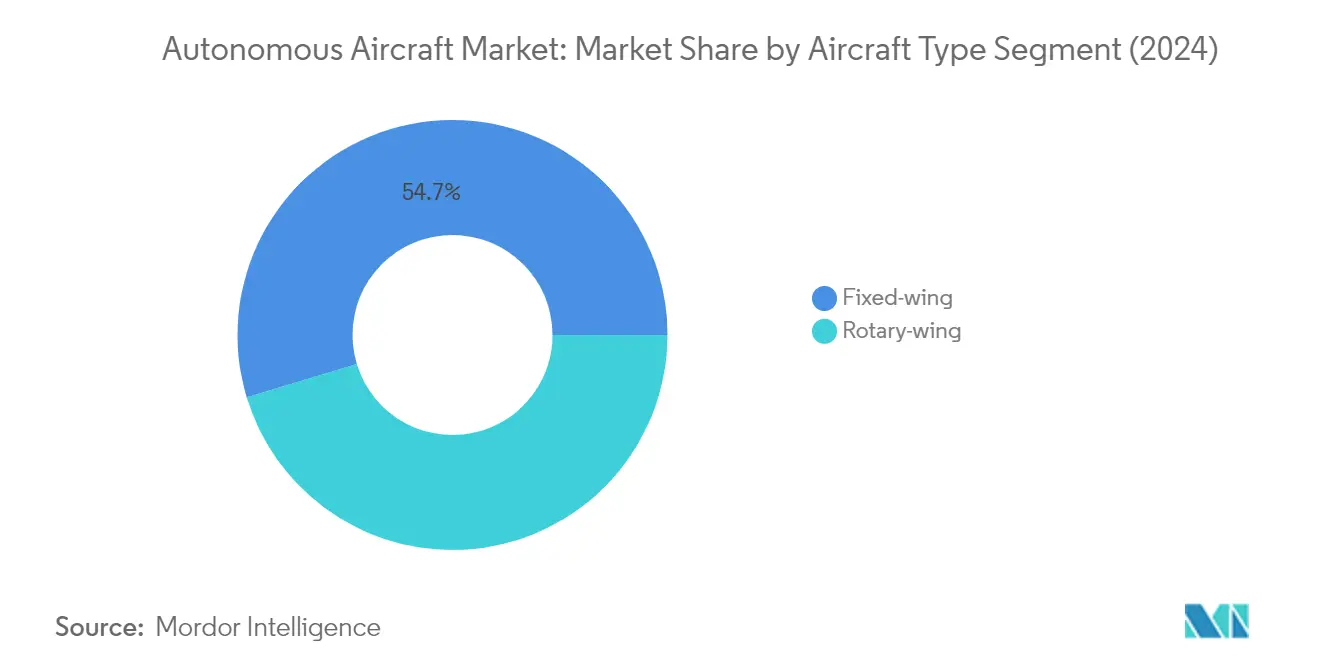Autonomous Aircraft Market Analysis
The Autonomous Aircraft Market size is estimated at USD 7.77 billion in 2025, and is expected to reach USD 17.09 billion by 2030, at a CAGR of 17.07% during the forecast period (2025-2030).
The autonomous aircraft industry is experiencing a transformative phase driven by technological innovation and increasing aviation demands. According to the International Air Transport Association (IATA), international air traffic witnessed a significant surge of 29.6% in July 2022 compared to the previous year, highlighting the growing strain on traditional aviation infrastructure. This surge in air traffic, coupled with the aviation industry's push toward automation, has accelerated the development of autonomous flight technology that can enhance operational efficiency and safety. The integration of artificial intelligence and machine learning technologies has enabled more sophisticated autonomous capabilities, with companies like Xwing leading the way in developing and testing automated flight systems.
The regulatory landscape for autonomous aircraft is evolving rapidly to accommodate technological advancements while ensuring safety standards. In October 2023, a significant milestone was achieved when EHang received the world's first airworthiness "type certificate" from the Civil Aviation Administration of China for its fully autonomous aerial vehicle, the EH216-S AAV. This breakthrough certification demonstrates the growing acceptance of autonomous aircraft technology by regulatory authorities and sets a precedent for future certifications worldwide. The industry is witnessing increased collaboration between manufacturers, technology providers, and regulatory bodies to establish comprehensive frameworks for autonomous aircraft operations.
The commercial aviation sector is undergoing substantial transformation, with Boeing's 2022 Commercial Market Outlook projecting the global commercial aviation fleet to double to 47,080 aircraft by 2041. This expansion is driving innovation in autonomous technologies, particularly in the cargo and logistics segments. In July 2023, Ribbit secured a USD 1.3 million contract with Transport Canada to begin testing unmanned aircraft in remote regions, demonstrating the growing confidence in autonomous systems for commercial applications. The successful completion of over 200 hours of hands-free flight testing by various companies indicates the technical feasibility and reliability of autonomous aircraft systems.
The industry is witnessing a surge in strategic partnerships and investments aimed at accelerating autonomous aircraft development. Major aerospace manufacturers are collaborating with technology companies to enhance autonomous capabilities and develop new applications. The U.S. Air Force's engagement with companies like Xwing through the AFWERX Prime program in 2023 demonstrates the military's growing interest in autonomous aviation technologies. These collaborations are fostering innovation in areas such as remote piloting systems, detect-and-avoid technologies, and autonomous navigation capabilities, setting the stage for broader adoption of autonomous aircraft across various sectors.
Autonomous Aircraft Market Trends
Pilot Shortage Driving Demand for Autonomous Systems
The global aviation industry is experiencing a severe pilot shortage crisis that is driving the demand for autonomous flight systems. According to Boeing's 2022 Pilot & Technician Outlook, the industry will require 602,000 new civil aviation pilots, 610,000 new maintenance technicians, and 899,000 new cabin crew members to operate and maintain the world fleet over the next 20 years. This shortage is further intensified by the significant growth in air passenger traffic, with the International Air Transport Association (IATA) reporting that international air traffic in July 2023 increased by 29.6% compared to July 2022, with Asia-Pacific airlines experiencing a remarkable 105.8% increase during the same period.
The growing pilot shortage has prompted airlines to pursue various strategies, including expanding their fleets while exploring autonomous flight systems. For instance, in October 2022, Alaska Airlines placed an order for 52 Boeing B737 MAX aircraft with plans to expand its fleet, while Luxembourg's Cargolux Airlines ordered ten B777-8 freighters with options for six additional aircraft. The cargo sector, in particular, has shown increased interest in autonomous VTOL systems, as cargo planes are expected to be the first adopters of autonomous aircraft technology due to zero passenger risk factors. This trend is evidenced by recent developments such as Xwing's May 2023 contract with the US Air Force to conduct pilotless cargo trials, which includes testing advanced flight control systems, auto takeoff/landing, and Detect-and-Avoid (DAA) systems on the Cessna 208B platform.
Increasing Investments into the Urban Air Mobility Ecosystem
The urban air mobility sector has witnessed substantial investment growth, with various stakeholders recognizing its potential to revolutionize urban transportation. Investment in the urban air mobility market reached approximately USD 5 billion in 2021 alone, with companies like Joby Aviation, Archer Aviation, Lilium, and Vertical Aerospace announcing significant Special-Purpose Acquisition Company (SPAC) investments to accelerate their market entry plans. This surge in investment has been accompanied by strategic partnerships between urban air mobility companies and established airlines, demonstrating the industry's commitment to developing a comprehensive urban air mobility ecosystem.
The sector has seen numerous groundbreaking partnerships and developments in 2023, highlighting the growing momentum in the urban air mobility market. For instance, Eve UAM's partnership with SkyWest Airlines includes a memorandum of understanding for the purchase of 100 electric vertical takeoff and landing aircraft (eVTOL), focusing on developing a deployment network throughout the United States. Similarly, major airlines have shown strong interest in the sector, with American Airlines pre-ordering up to 250 aircraft from Vertical Aerospace, and United Airlines placing a substantial order for autonomous air taxi aircraft from Archer Aviation. Infrastructure development has also gained traction, as evidenced by Urban-Air Port's ambitious plan to develop 65 urban air mobility infrastructure hubs across key locations in the United States, the United Kingdom, the European Union, and the Asia-Pacific region, addressing the critical need for supporting infrastructure in the UAM ecosystem.
Segment Analysis: By Aircraft Type
Fixed-wing Segment in Autonomous Aircraft Market
The fixed-wing segment dominates the autonomous aircraft market, commanding approximately 55% of the market share in 2024. This significant market position is attributed to the segment's extensive applications in military operations, particularly in intelligence gathering, surveillance, and reconnaissance missions. The evolution of modern warfare has led to increased adoption of fixed-wing autonomous aircraft as force multipliers that can map targets, utilize electronic warfare capabilities to jam enemy signals, and execute airstrikes. The segment's prominence is further strengthened by ongoing developments in artificial intelligence and autonomous flight control systems, enabling these aircraft to operate effectively in complex environments. Major defense contractors continue to invest heavily in fixed-wing unmanned aircraft development, focusing on enhancing their capabilities for both tactical and strategic applications.
Rotary-wing Segment in Autonomous Aircraft Market
The rotary-wing segment is emerging as the fastest-growing segment in the autonomous aircraft market, projected to grow at approximately 18% CAGR from 2024 to 2029. This remarkable growth is driven by the segment's unique capabilities in vertical takeoff and landing (VTOL), making it ideal for urban air mobility applications, emergency response operations, and specialized military missions. The increasing adoption of autonomous helicopters in commercial applications, such as cargo delivery, infrastructure inspection, and agricultural operations, is fueling this growth. Technological advancements in autonomous flight control systems, enhanced sensor integration, and improved battery technologies are making rotary-wing platforms more capable and reliable. The segment is witnessing significant investments from both traditional aerospace companies and innovative startups, particularly in developing electric VTOL (eVTOL) platforms for urban air mobility solutions.
Segment Analysis: By Application
Tactical Segment in Autonomous Aircraft Market
The tactical segment dominates the autonomous aircraft market, commanding approximately 59% market share in 2024. This significant market position is driven by increasing defense expenditure globally and the growing adoption of autonomous systems for military applications. Military forces worldwide are incorporating tactical unmanned aircraft for various missions, including intelligence gathering, surveillance, reconnaissance, and combat operations. The segment's prominence is further strengthened by continuous technological advancements in artificial intelligence, sensor technologies, and autonomous control systems that enhance the capabilities of tactical autonomous aircraft. Major defense contractors are actively developing and deploying sophisticated tactical autonomous platforms that can operate independently or in coordination with manned aircraft, contributing to the segment's market leadership.
Passenger Aircraft Segment in Autonomous Aircraft Market
The passenger aircraft segment is emerging as the fastest-growing segment in the autonomous aircraft market, with a projected growth rate of approximately 29% during 2024-2029. This remarkable growth is primarily driven by increasing investments in urban air mobility solutions and the development of autonomous air taxis. The segment is witnessing substantial technological innovations, particularly in electric vertical takeoff and landing (eVTOL) platforms designed for passenger transport. Companies like EHang and Volocopter are leading the way with their autonomous passenger aircraft developments, while traditional aerospace manufacturers are also entering this space with their own autonomous passenger transport solutions. The growth is further supported by favorable regulatory developments and increasing acceptance of autonomous passenger aircraft for urban transportation.
Remaining Segments in Autonomous Aircraft Market by Application
The cargo aircraft segment represents a significant portion of the autonomous aircraft market, bridging the gap between tactical and passenger applications. This segment is experiencing substantial growth driven by the increasing demand for autonomous cargo delivery solutions, particularly in the e-commerce and logistics sectors. Major logistics companies and retailers are exploring autonomous cargo aircraft for last-mile delivery, while military forces are utilizing these platforms for supply chain operations in remote or hostile environments. The segment benefits from relatively fewer regulatory hurdles compared to passenger aircraft, as cargo operations pose lower safety risks, making it an attractive option for early adoption of autonomous technology in commercial applications.
Segment Analysis: By End User
Defense Segment in Autonomous Aircraft Market
The defense segment continues to dominate the autonomous aircraft market, commanding approximately 73% market share in 2024. This significant market position is driven by increasing defense budgets worldwide and growing investments in autonomous military capabilities. Defense forces globally are incorporating autonomous aerial vehicles systems for various critical missions, including intelligence gathering, surveillance, reconnaissance, and combat operations. The integration of advanced technologies like artificial intelligence and machine learning has enhanced the capabilities of military autonomous aircraft, making them indispensable for modern warfare scenarios. Major defense contractors are developing sophisticated autonomous platforms that can operate alongside traditional manned aircraft, creating effective human-machine teaming capabilities. The segment's growth is further supported by ongoing military modernization programs across various nations and the increasing focus on reducing human risk in combat situations through autonomous systems.
Commercial Segment in Autonomous Aircraft Market
The commercial segment is experiencing remarkable growth and is projected to expand at approximately 29% CAGR during 2024-2029, emerging as the fastest-growing segment in the autonomous aircraft market. This exceptional growth is primarily driven by increasing investments in urban air mobility solutions and the rising demand for autonomous cargo delivery systems. The segment is witnessing substantial technological advancements in areas such as autonomous flight control systems, obstacle detection, and navigation capabilities. Commercial applications are expanding rapidly, ranging from package delivery services to potential air taxi operations in urban environments. The development of supporting infrastructure, including vertiports and autonomous traffic management systems, is further accelerating segment growth. Additionally, the increasing focus on reducing operational costs and addressing pilot shortage issues in commercial aviation is pushing airlines and logistics companies to explore autonomous aircraft solutions, contributing to the segment's rapid expansion.
Autonomous Aircraft Market Geography Segment Analysis
Autonomous Aircraft Market in North America
North America represents a pivotal market for autonomous aircraft, driven by significant technological advancements and robust aerospace infrastructure. The region benefits from the presence of major aerospace manufacturers, advanced technological capabilities, and supportive regulatory frameworks. Both the United States and Canada have shown strong commitment to developing autonomous aircraft capabilities, with a particular focus on military applications and urban air mobility solutions. The region's leadership in artificial intelligence and machine learning technologies has further accelerated the development and integration of autonomous systems in aircraft.
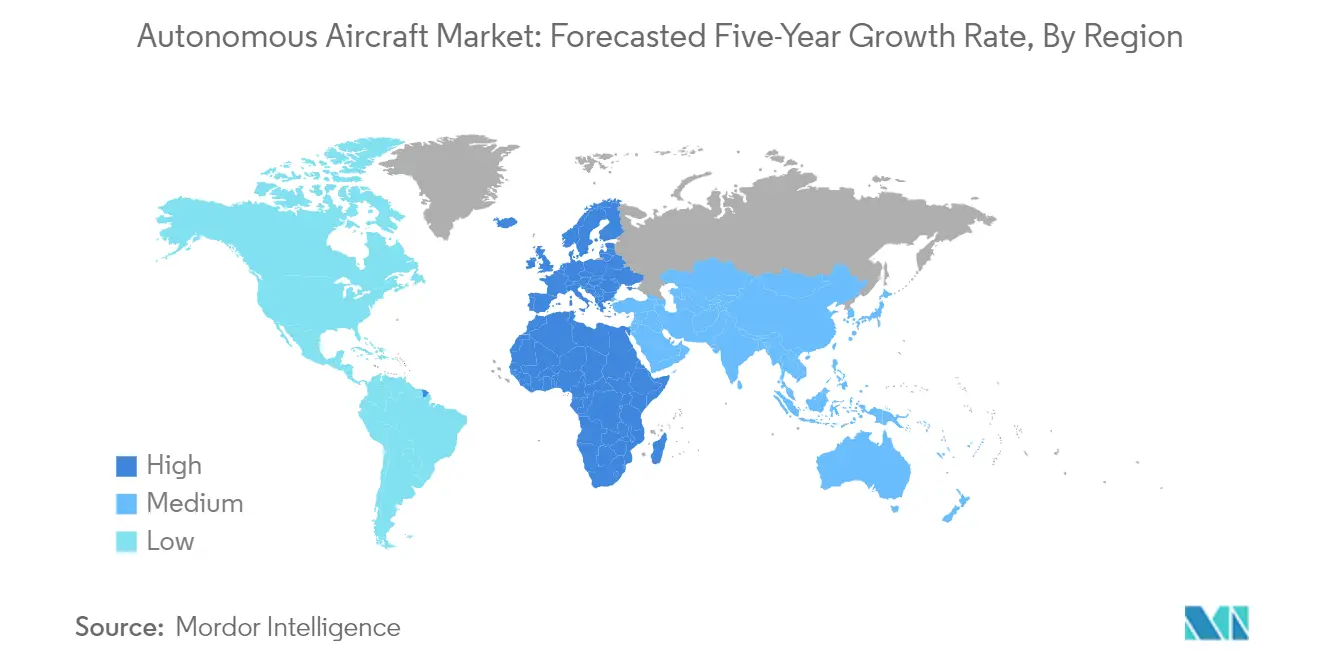
Autonomous Aircraft Market in United States
The United States dominates the North American autonomous aircraft landscape, holding approximately 94% of the regional market share in 2024. The country has been at the forefront of autonomous aviation development, particularly in military applications and urban air mobility solutions. The U.S. Department of Defense maintains a substantial fleet of unmanned aircraft, ranging from tactical to strategic platforms. The country's robust aerospace industry, supported by significant research and development investments, continues to drive innovation in autonomous aircraft technologies. The Federal Aviation Administration's progressive approach to regulatory frameworks has also facilitated the testing and deployment of autonomous systems across various applications.
Autonomous Aircraft Market in Canada
Canada emerges as the fastest-growing market in North America, with a projected growth rate of approximately 19% during 2024-2029. The country's autonomous aircraft sector is particularly focused on developing solutions for remote and rural areas, where traditional transportation faces significant challenges. Canada's aerospace industry, with major hubs in Quebec and Ontario, has been actively developing autonomous aircraft technologies for both civilian and military applications. The country's vast geography and challenging terrain have created unique opportunities for autonomous cargo aircraft deployment, particularly in cargo delivery and remote surveillance operations. The Canadian government's supportive policies and investments in advanced air mobility have created a favorable environment for market growth.
Autonomous Aircraft Market in Europe
Europe represents a significant market for autonomous aircraft, characterized by strong collaboration between countries and a unified regulatory approach under the European Union Aviation Safety Agency. The region's market is driven by both military and commercial applications, with particular emphasis on urban air mobility solutions. Countries like the United Kingdom, France, Germany, and Italy are leading the development of autonomous aircraft technologies, supported by established aerospace manufacturers and research institutions. The region's focus on sustainable aviation solutions has also accelerated the development of electric and hybrid autonomous aircraft systems.
Autonomous Aircraft Market in United Kingdom
The United Kingdom leads the European autonomous aircraft market, commanding approximately 34% of the regional market share in 2024. The country's strong aerospace industry, supported by advanced research facilities and technological expertise, has positioned it as a leader in autonomous aviation development. The UK has made significant strides in developing urban air mobility solutions, including the world's first urban drone airport in Coventry. The country's defense sector has also been actively investing in autonomous aircraft technologies, particularly in the development of combat air systems and surveillance platforms.
Autonomous Aircraft Market in United Kingdom - Growth Analysis
The United Kingdom also demonstrates the highest growth potential in Europe, with a projected growth rate of approximately 18% during 2024-2029. This growth is driven by increasing investments in autonomous aircraft infrastructure and supportive government policies. The country's Project Skyway, the world's longest autonomous drone superhighway, exemplifies its commitment to advancing autonomous aircraft capabilities. The UK's focus on developing comprehensive autonomous aircraft ecosystems, including vertiports and air traffic management systems, has created a strong foundation for sustained market growth.
Autonomous Aircraft Market in Asia-Pacific
The Asia-Pacific region represents a dynamic market for autonomous aircraft, characterized by rapid technological adoption and increasing investments in aerospace infrastructure. Countries like China, India, Japan, and South Korea are actively developing autonomous aircraft capabilities, with applications ranging from military surveillance to urban air mobility. The region's diverse geography and growing urbanization have created unique opportunities for autonomous aircraft deployment, particularly in logistics and transportation applications.
Autonomous Aircraft Market in China
China leads the Asia-Pacific autonomous aircraft market, demonstrating strong capabilities in both military and commercial applications. The country's focus on developing indigenous autonomous aircraft technologies, supported by substantial government investments and regulatory reforms, has established it as a regional leader. Chinese companies have made significant progress in developing autonomous passenger aircraft, with several successful flight tests and certifications achieved.
Autonomous Aircraft Market in Japan
Japan emerges as the fastest-growing market in the Asia-Pacific region, driven by its advanced technological capabilities and strong focus on urban air mobility solutions. The country's strategic initiatives, including the formation of the Next Generation Aviation Mobility Planning Office, demonstrate its commitment to autonomous aircraft development. Japanese companies have formed significant partnerships with international players to accelerate the development and deployment of autonomous aircraft technologies.
Autonomous Aircraft Market in Latin America
Latin America's autonomous aircraft market is experiencing significant growth, with Brazil emerging as both the largest and fastest-growing market in the region. The region's focus on developing autonomous aircraft capabilities is driven by diverse applications, including agricultural monitoring, security surveillance, and urban mobility solutions. While regulatory frameworks are still evolving, countries in the region are increasingly recognizing the potential of autonomous aircraft technologies and investing in related infrastructure and research capabilities.
Autonomous Aircraft Market in Middle East & Africa
The Middle East & Africa region demonstrates growing interest in autonomous aircraft technologies, with Israel leading in market size and the United Arab Emirates showing the fastest growth. The region's autonomous aircraft market is characterized by strong defense applications and increasing focus on urban air mobility solutions. Countries across the region are investing in infrastructure development and regulatory frameworks to support the growth of autonomous aircraft operations, particularly in areas such as cargo delivery, surveillance, and urban transportation.
Autonomous Aircraft Industry Overview
Top Companies in Autonomous Aircraft Market
The autonomous aircraft market is characterized by intense innovation and strategic developments from major players like Northrop Grumman, Boeing, Lockheed Martin, BAE Systems, and Airbus SE. Companies are heavily investing in research and development to advance autonomous flight technology, particularly focusing on AI integration, machine learning capabilities, and enhanced sensor systems. Strategic collaborations between manufacturers, technology firms, and research institutions have become increasingly common to accelerate technological advancement and market penetration. Operational agility is demonstrated through the development of modular platforms that can be rapidly adapted for different mission profiles and customer requirements. Market leaders are expanding their geographical presence through partnerships with local industries and establishing dedicated regional divisions to better serve diverse market needs. Product portfolios are being diversified to include both military and commercial applications, with particular emphasis on cargo transport solutions and urban air mobility platforms.
Defense Giants Lead Consolidated Market Structure
The unmanned aircraft industry exhibits a highly consolidated structure dominated by established defense and aerospace conglomerates with extensive technological capabilities and robust financial resources. These major players leverage their existing relationships with defense departments and commercial aviation customers, while maintaining significant barriers to entry through their advanced technological expertise and intellectual property portfolios. The market shows a clear distinction between global defense contractors who lead in military applications and emerging specialists focusing on commercial autonomous solutions, particularly in the urban air mobility segment.
Recent market dynamics indicate increasing merger and acquisition activities, with larger companies acquiring innovative startups to enhance their autonomous capabilities and maintain competitive advantages. Strategic partnerships are forming between traditional aerospace manufacturers and technology companies, combining aviation expertise with cutting-edge autonomous aviation systems development. Regional players are gaining prominence through specialized offerings and local market knowledge, though they often operate in collaboration with global leaders rather than direct competition.
Innovation and Adaptability Drive Future Success
Success in the autonomous aircraft market increasingly depends on companies' ability to navigate complex regulatory environments while maintaining technological leadership. Incumbent players must focus on developing scalable autonomous solutions that can be adapted across different market segments, from military applications to commercial cargo transport and urban air mobility. The ability to demonstrate safety and reliability through extensive testing and certification processes remains crucial for market acceptance and regulatory approval. Companies need to maintain strong relationships with key stakeholders, including government agencies, while simultaneously investing in next-generation technologies to stay ahead of evolving market demands.
For new entrants and emerging players, success lies in identifying and exploiting specific market niches where they can offer unique value propositions. This includes developing specialized autonomous aerial vehicle solutions for specific applications or regional markets, particularly in areas where larger players may have less focus. Building strategic partnerships with established aerospace companies while maintaining technological independence through proprietary innovations is crucial. Companies must also consider the increasing importance of sustainability and environmental regulations in shaping future market opportunities, while maintaining flexibility to adapt to changing end-user requirements and technological advances.
Autonomous Aircraft Market Leaders
-
Airbus SE
-
BAE Systems plc
-
Northrop Grumman Corporation
-
Textron Inc.
-
The Boeing Company
- *Disclaimer: Major Players sorted in no particular order
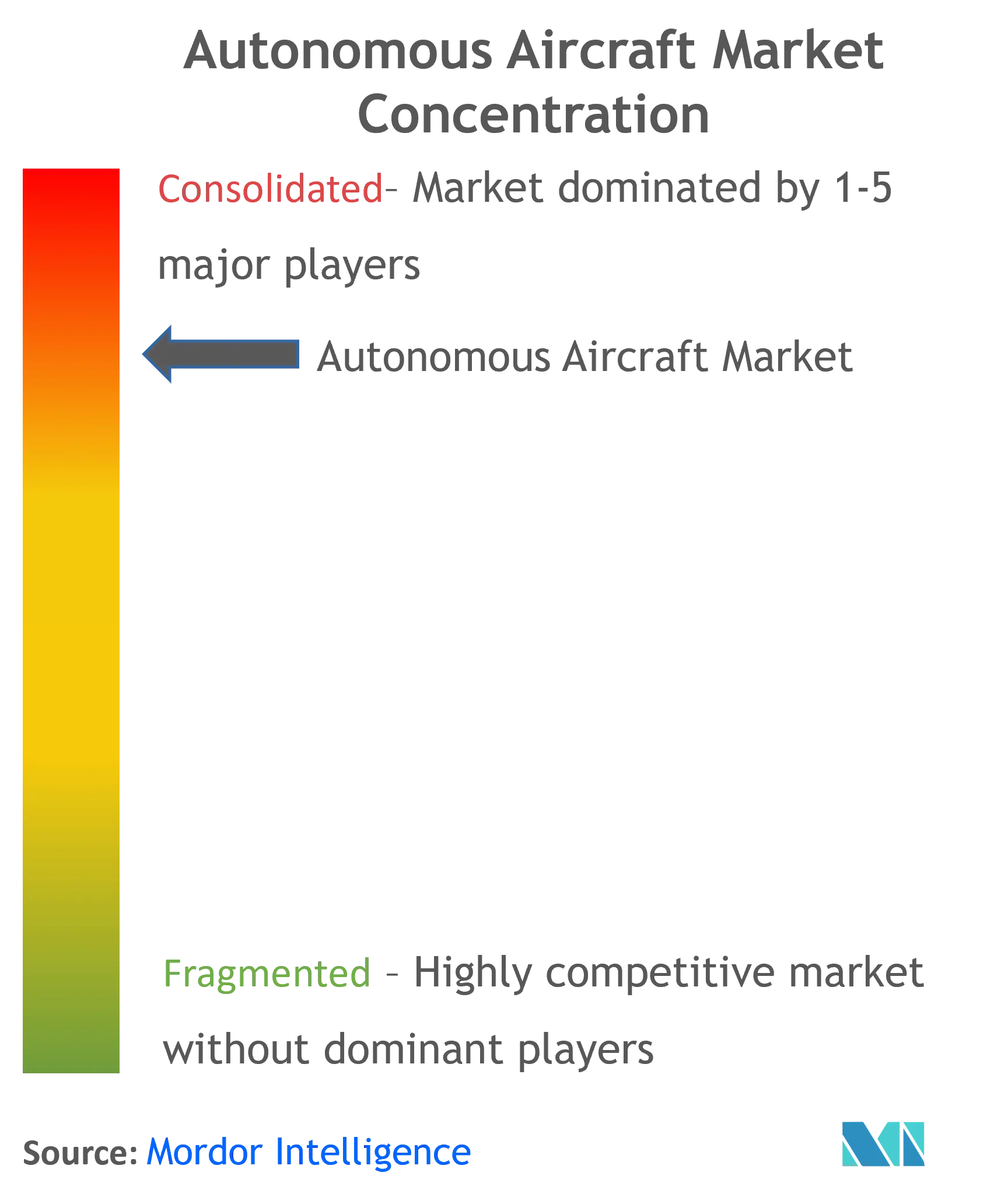
Autonomous Aircraft Market News
July 2023: The US Defense Advanced Research Project Agency's (DARPA) Tactical Technology Office awarded Northrop Grumman Corporation a contract to develop an autonomous vertical takeoff and landing (VTOL) uncrewed aircraft system capable of operating from a moving Navy ship at sea.
May 2023: Xwing was awarded a Phase II Small Business Innovation Research Contract (SBIRC) with the US Air Force's AFWE Prime program. Under the agreement, Xwing will carry out independently conducted flight tests using its Superpilot helicopter system to improve the development of remote piloting and optimize technology for future missions. The trials will be conducted on the Cessna 208B to obtain feedback from users as quickly as possible in terms of user convenience, mission planning factors, and functions for future efforts.
Autonomous Aircraft Market Report - Table of Contents
1. INTRODUCTION
- 1.1 Study Assumptions and Market Definition
- 1.2 Scope of the Study
2. RESEARCH METHODOLOGY
3. EXECUTIVE SUMMARY
4. MARKET DYNAMICS
- 4.1 Market Overview
- 4.2 Market Drivers
- 4.3 Market Restraints
-
4.4 Porter's Five Forces Analysis
- 4.4.1 Bargaining Power of Suppliers
- 4.4.2 Bargaining Power of Buyers/Consumers
- 4.4.3 Threat of New Entrants
- 4.4.4 Threat of Substitute Products
- 4.4.5 Intensity of Competitive Rivalry
5. MARKET SEGMENTATION
-
5.1 Aircraft Type
- 5.1.1 Fixed-wing
- 5.1.2 Rotary-wing
-
5.2 Application
- 5.2.1 Cargo Aircraft
- 5.2.2 Passenger Aircraft
-
5.3 End-user
- 5.3.1 Commercial
- 5.3.2 Defense
-
5.4 Geography
- 5.4.1 North America
- 5.4.1.1 United States
- 5.4.1.2 Canada
- 5.4.2 Europe
- 5.4.2.1 United Kingdom
- 5.4.2.2 France
- 5.4.2.3 Germany
- 5.4.2.4 Italy
- 5.4.2.5 Russia
- 5.4.2.6 Rest of Europe
- 5.4.3 Asia-Pacific
- 5.4.3.1 China
- 5.4.3.2 India
- 5.4.3.3 Japan
- 5.4.3.4 South Korea
- 5.4.3.5 Rest of Asia-Pacific
- 5.4.4 Latin America
- 5.4.4.1 Brazil
- 5.4.4.2 Mexico
- 5.4.4.3 Rest of Latin America
- 5.4.5 Middle East and Africa
- 5.4.5.1 Saudi Arabia
- 5.4.5.2 United Arab Emirates
- 5.4.5.3 Turkey
- 5.4.5.4 South Africa
- 5.4.5.5 Rest of Middle East and Africa
6. COMPETITIVE LANDSCAPE
- 6.1 Vendor Market Share
-
6.2 Company Profiles
- 6.2.1 Northrop Grumman Corporation
- 6.2.2 The Boeing Company
- 6.2.3 Lockheed Martin Corporation
- 6.2.4 RTX Corporation
- 6.2.5 Elbit Systems Ltd
- 6.2.6 AeroVironment Inc.
- 6.2.7 Saab AB
- 6.2.8 BAE Systems PLC
- 6.2.9 Airbus SE
- 6.2.10 Textron Inc.
- 6.2.11 IAI
- *List Not Exhaustive
7. MARKET OPPORTUNITIES AND FUTURE TRENDS
Autonomous Aircraft Industry Segmentation
Autonomous aircraft can be defined as an unmanned aircraft that does not require pilot intervention in the management of the flight.
The autonomous aircraft market is segmented by aircraft type, end-user, application, and geography. By end-user, the market is segmented into commercial and defense. By application, the market is segmented into cargo aircraft and passenger aircraft. The market is segmented by aircraft type into fixed-wing and rotary-wing. The report also covers the market sizes and forecasts for the autonomous aircraft market in major countries across different regions. For each segment, the market sizing and forecasts have been done based on value (USD).
| Aircraft Type | Fixed-wing | ||
| Rotary-wing | |||
| Application | Cargo Aircraft | ||
| Passenger Aircraft | |||
| End-user | Commercial | ||
| Defense | |||
| Geography | North America | United States | |
| Canada | |||
| Europe | United Kingdom | ||
| France | |||
| Germany | |||
| Italy | |||
| Russia | |||
| Rest of Europe | |||
| Asia-Pacific | China | ||
| India | |||
| Japan | |||
| South Korea | |||
| Rest of Asia-Pacific | |||
| Latin America | Brazil | ||
| Mexico | |||
| Rest of Latin America | |||
| Middle East and Africa | Saudi Arabia | ||
| United Arab Emirates | |||
| Turkey | |||
| South Africa | |||
| Rest of Middle East and Africa | |||
Autonomous Aircraft Market Research FAQs
How big is the Autonomous Aircraft Market?
The Autonomous Aircraft Market size is expected to reach USD 7.77 billion in 2025 and grow at a CAGR of 17.07% to reach USD 17.09 billion by 2030.
What is the current Autonomous Aircraft Market size?
In 2025, the Autonomous Aircraft Market size is expected to reach USD 7.77 billion.
Who are the key players in Autonomous Aircraft Market?
Airbus SE, BAE Systems plc, Northrop Grumman Corporation, Textron Inc. and The Boeing Company are the major companies operating in the Autonomous Aircraft Market.
Which is the fastest growing region in Autonomous Aircraft Market?
North America is estimated to grow at the highest CAGR over the forecast period (2025-2030).
Which region has the biggest share in Autonomous Aircraft Market?
In 2025, the North America accounts for the largest market share in Autonomous Aircraft Market.
What years does this Autonomous Aircraft Market cover, and what was the market size in 2024?
In 2024, the Autonomous Aircraft Market size was estimated at USD 6.44 billion. The report covers the Autonomous Aircraft Market historical market size for years: 2019, 2020, 2021, 2022, 2023 and 2024. The report also forecasts the Autonomous Aircraft Market size for years: 2025, 2026, 2027, 2028, 2029 and 2030.
Our Best Selling Reports
Autonomous Aircraft Market Research
Mordor Intelligence delivers a comprehensive analysis of the autonomous aircraft industry, leveraging decades of expertise in aviation market research. Our latest report examines the evolving landscape of unmanned aircraft and pilotless aircraft technologies. It includes developments in autonomous flight technology and autonomous flight systems. The analysis covers various segments, from autonomous drones and autonomous helicopters to advanced autonomous aerial vehicles. There is a particular focus on emerging urban air mobility solutions and autonomous flight control systems.
Stakeholders across the industry can access detailed insights through our easy-to-download report PDF, which explores the transformation of autonomous aviation through various applications. The report examines developments in autonomous air taxi services, autonomous cargo aircraft, and autonomous passenger aircraft segments. It also analyzes the potential of autonomous VTOL and autonomous eVTOL technologies. Our research provides valuable intelligence on autonomous airplane developments and the growing urban air mobility market. This offers stakeholders a comprehensive understanding of market dynamics and technological advancements in autonomous flying vehicles.

